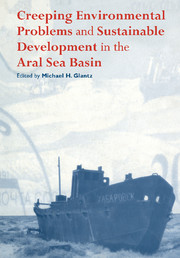Book contents
- Frontmatter
- Contents
- List of contributors
- Introduction
- 1 Sustainable development and creeping environmental problems in the Aral Sea region
- 2 Ecological disaster linked to landscape composition changes in the Aral Sea basin
- 3 Alteration of water level and salinity of the Aral Sea
- 4 Desertification in the Aral Sea region
- 5 Climate fluctuations and change in the Aral Sea basin within the last 50 years
- 6 Priaralye ecosystems and creeping environmental changes in the Aral Sea
- 7 Public health in the Aral Sea coastal region and the dynamics of changes in the ecological situation
- 8 The impact of political ideology on creeping environmental changes in the Aral Sea basin
- 9 Change of the rivers' flow in the Aral Sea basin (in connection with the problem of quantitative assessment and consideration of environmental after-effects)
- 10 Fish population as an ecosystem component and economic object in the Aral Sea basin
- 11 Creeping environmental changes in the Karakum Canal's zone of impact
- 12 Environmental changes in the Uzbek part of the Aral Sea basin
- 13 Creeping changes in biological communities in the Aral Sea
- Index
8 - The impact of political ideology on creeping environmental changes in the Aral Sea basin
Published online by Cambridge University Press: 19 October 2009
- Frontmatter
- Contents
- List of contributors
- Introduction
- 1 Sustainable development and creeping environmental problems in the Aral Sea region
- 2 Ecological disaster linked to landscape composition changes in the Aral Sea basin
- 3 Alteration of water level and salinity of the Aral Sea
- 4 Desertification in the Aral Sea region
- 5 Climate fluctuations and change in the Aral Sea basin within the last 50 years
- 6 Priaralye ecosystems and creeping environmental changes in the Aral Sea
- 7 Public health in the Aral Sea coastal region and the dynamics of changes in the ecological situation
- 8 The impact of political ideology on creeping environmental changes in the Aral Sea basin
- 9 Change of the rivers' flow in the Aral Sea basin (in connection with the problem of quantitative assessment and consideration of environmental after-effects)
- 10 Fish population as an ecosystem component and economic object in the Aral Sea basin
- 11 Creeping environmental changes in the Karakum Canal's zone of impact
- 12 Environmental changes in the Uzbek part of the Aral Sea basin
- 13 Creeping changes in biological communities in the Aral Sea
- Index
Summary
The Aral Sea is a part of a self-regulating hydrological system. It receives water from the two largest rivers in Central Asia, the Amudarya and Syrdarya, and the sea water evaporates into the atmosphere. Changes in this balance have a primary effect on the water level of the sea. These rivers flowing to the Aral have exhibited extremely uneven flow from one year to the next. For example, during a 60-year period, the Syrdarya's annual flow ranged from 22 to 57 km3, with a mean value of 34 km3; the Amudarya's flow ranged from 48 to 101 km3,with a mean value of 63 km3. A ‘periodicity’ of low-flow and high-flow periods has been observed to last 10–12 years. Clearly, the decrease of river flow to the sea results in a drop in sea level, in a reduction of sea surface area and volume, and in changes in other characteristics of the sea.
Irrigation farming in the Aral Sea basin began at least as early as 4000 BC. The local population of this region, like those in the valleys of the Tigris, Euphrates and Nile rivers, shared the experiences and knowledge accumulated over generations about the use of regional water resources, and about how to carry out irrigation farming in river floodplains and deltas in arid areas without disturbing the balance of nature.
The major disturbance of the long-lasting natural balance between ecological change in the Aral basin and the sea began early in the twentieth century as a result of human activities. Before then, the sea was abundant in water and even had a tendency to rise, despite the onset of intensive colonization of the region by Tsarist Russia.
- Type
- Chapter
- Information
- Publisher: Cambridge University PressPrint publication year: 1999
- 3
- Cited by



